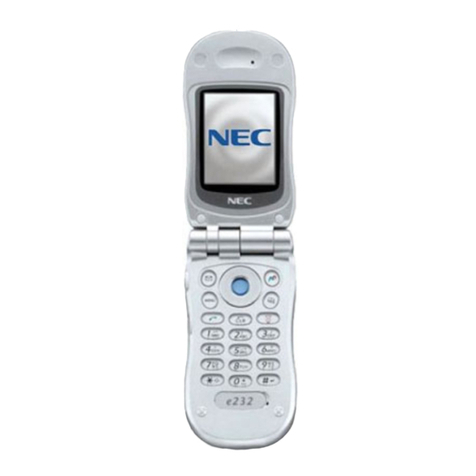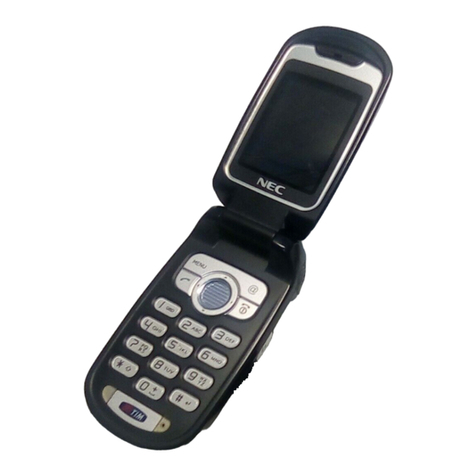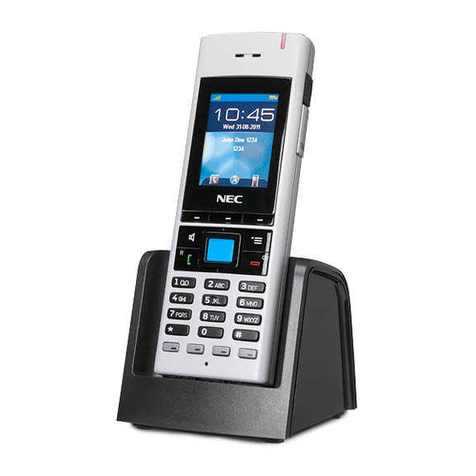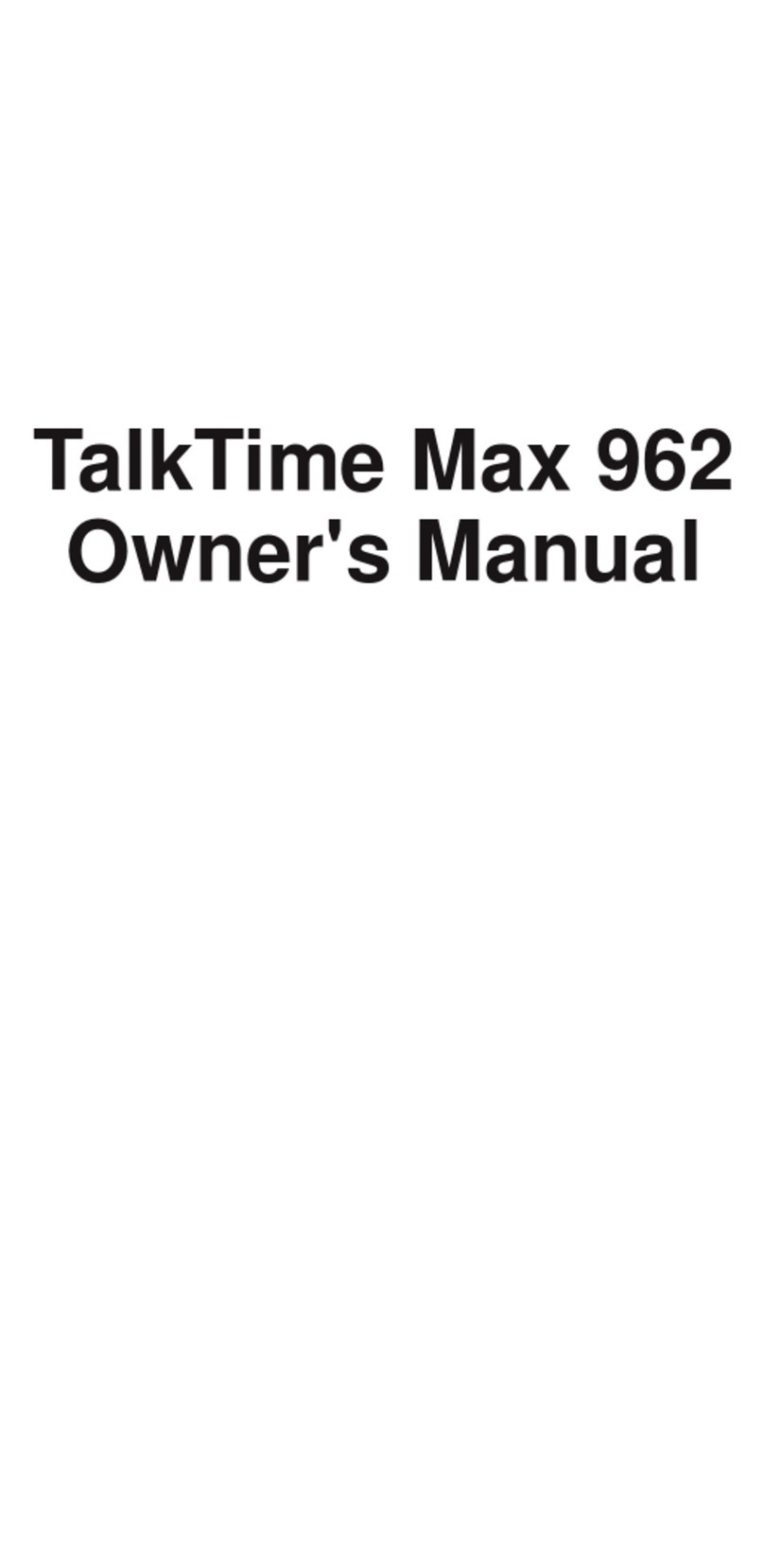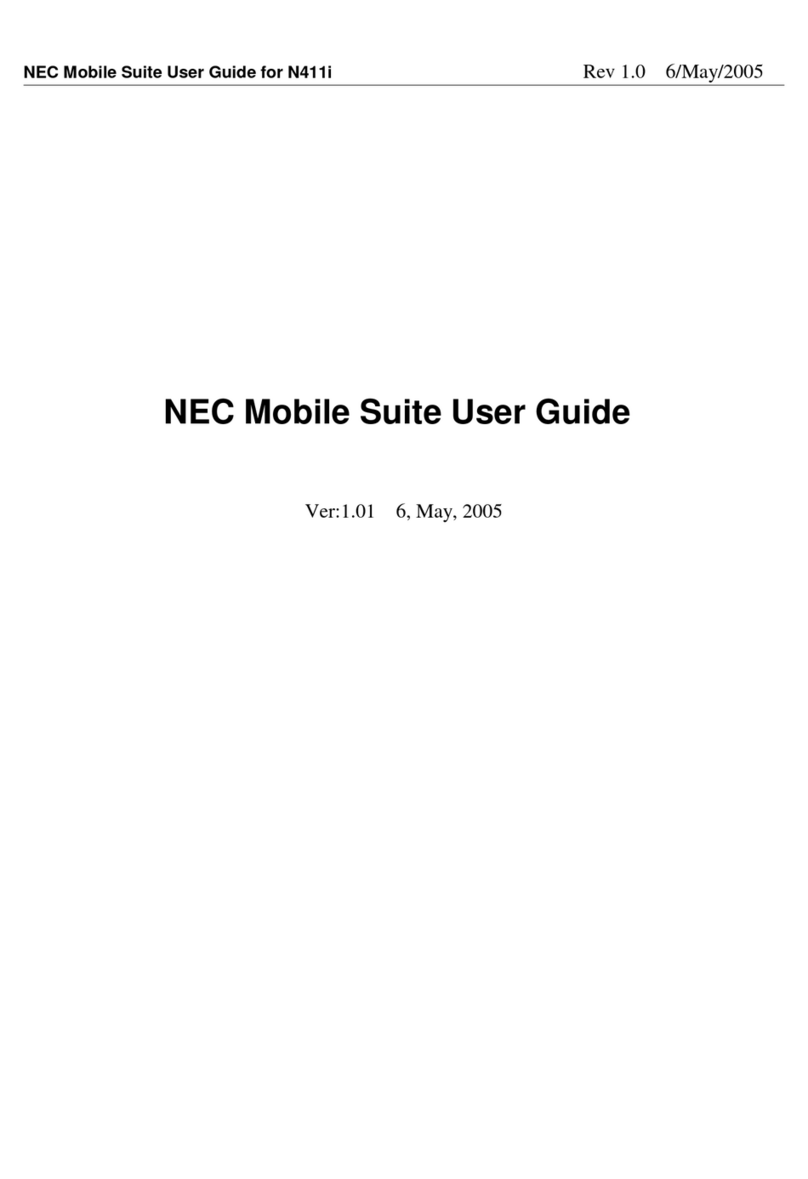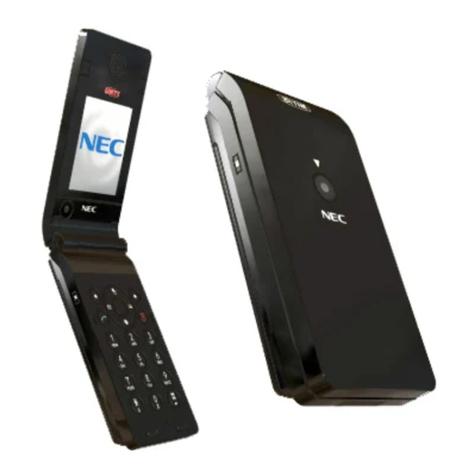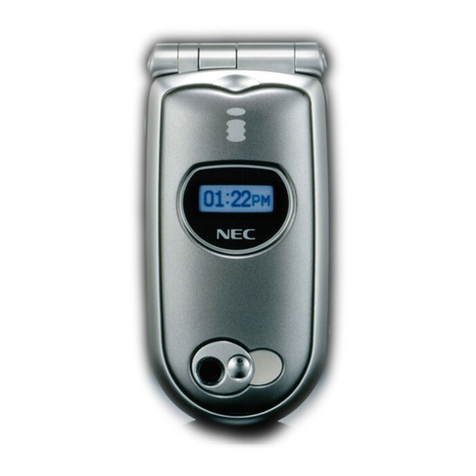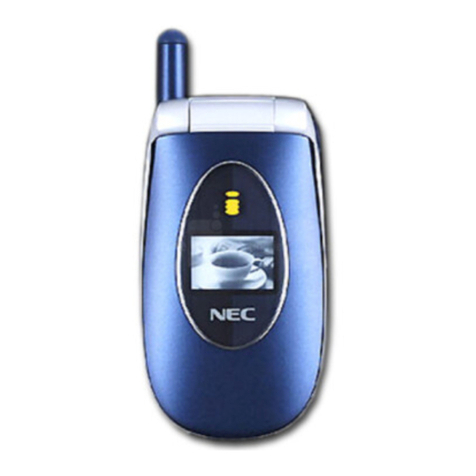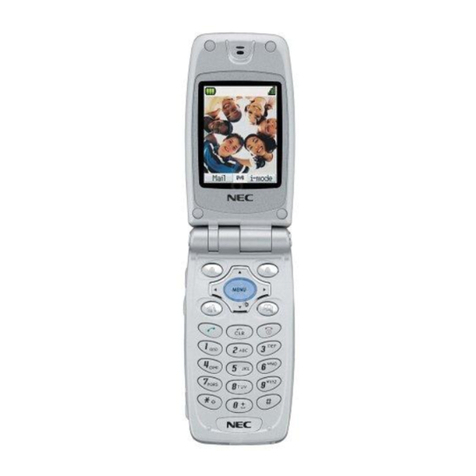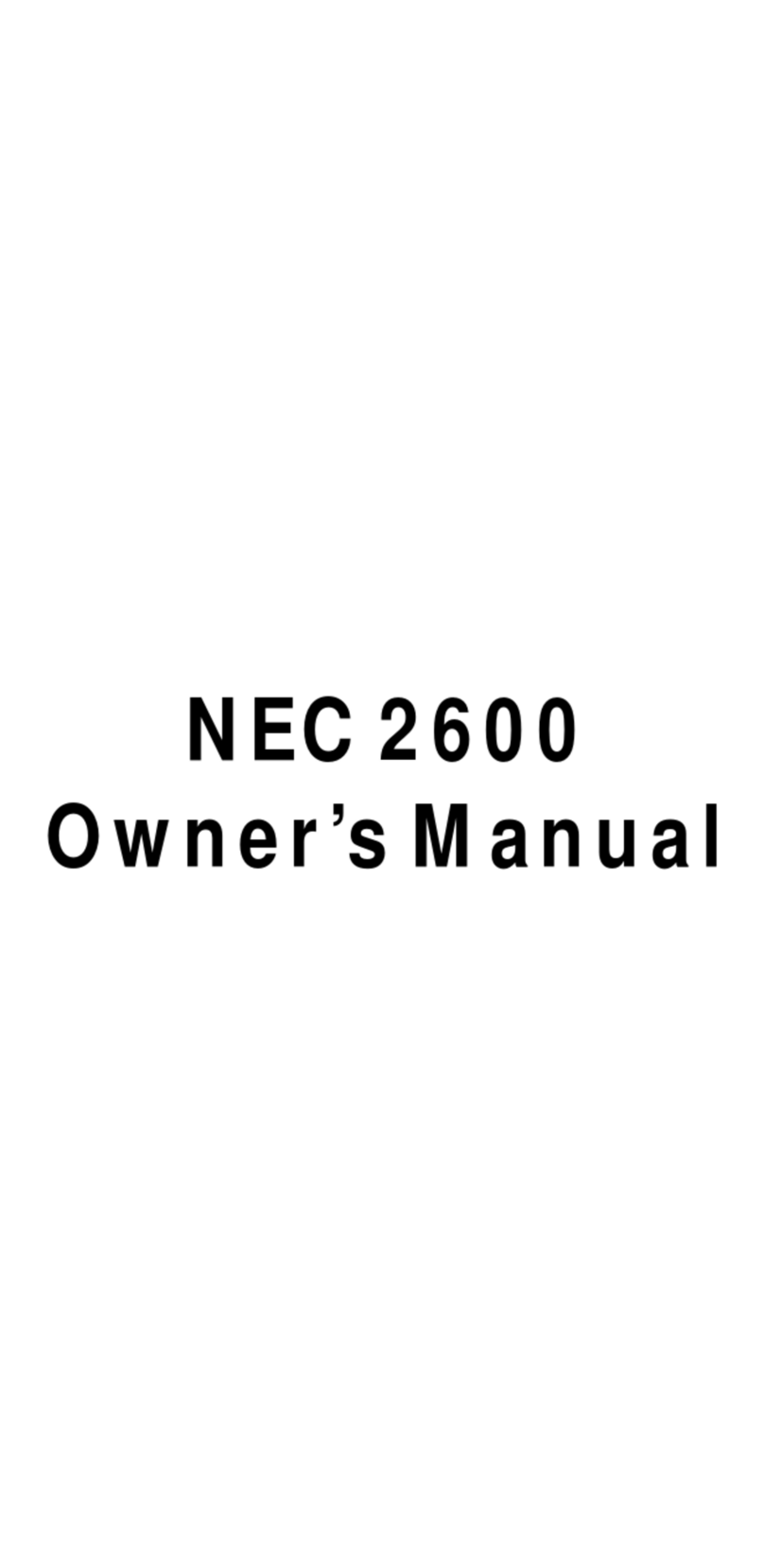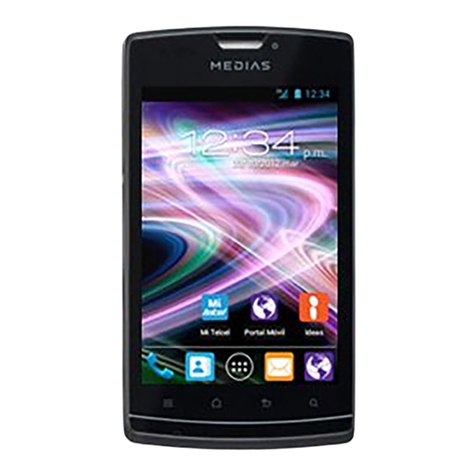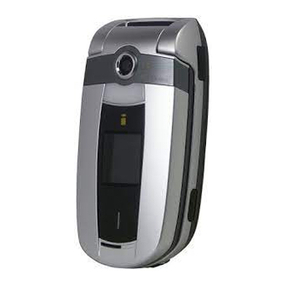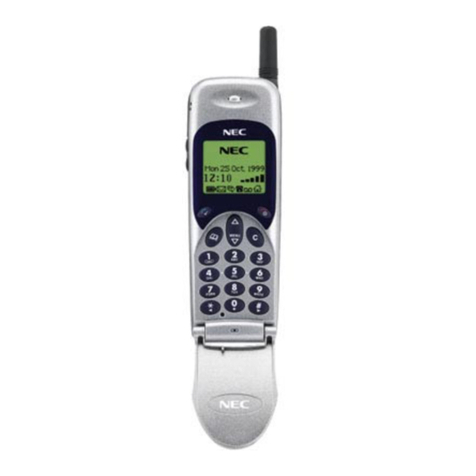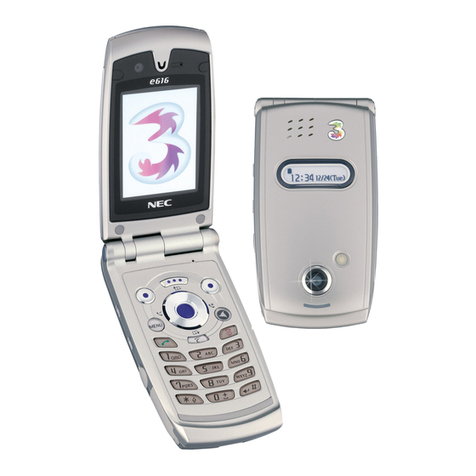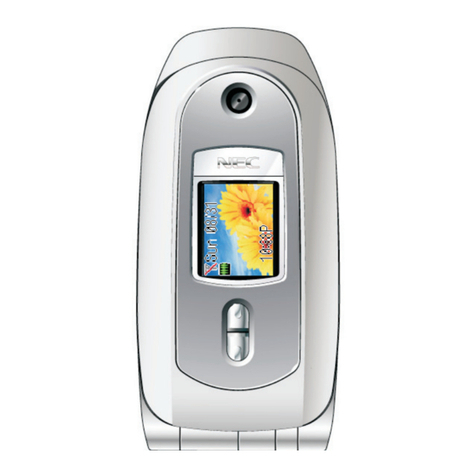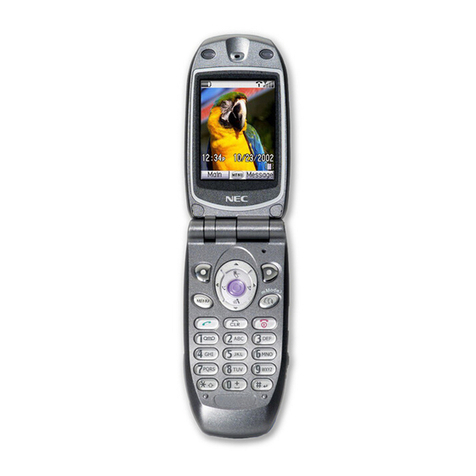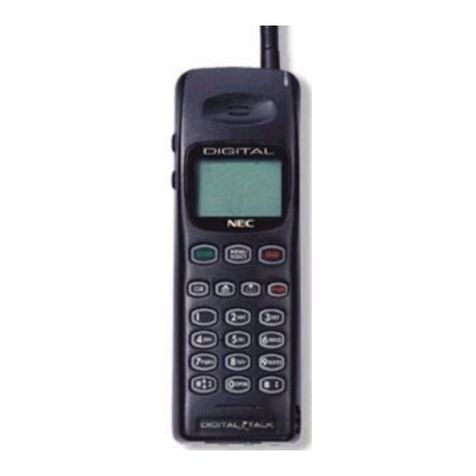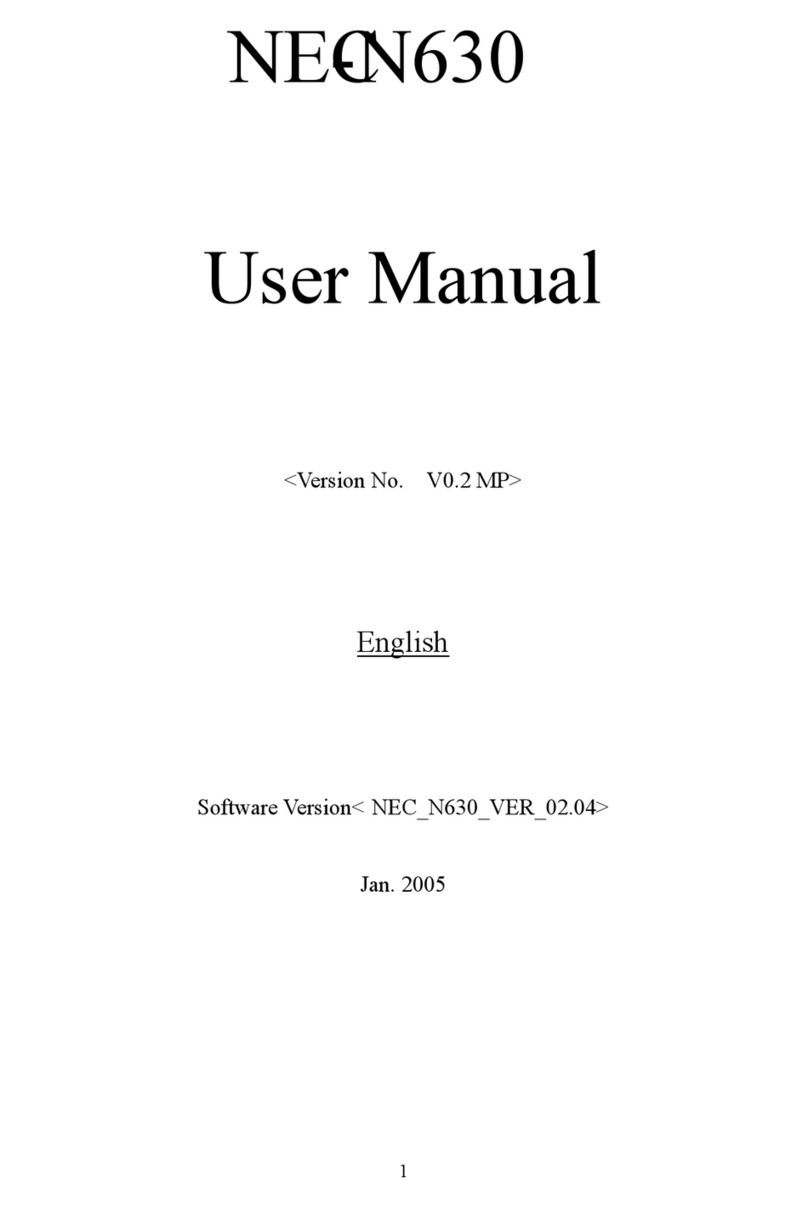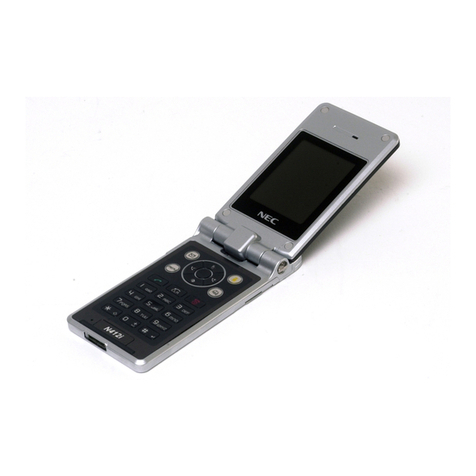NEC DB500 User manual

Emergency Services and Safety Precautions
Emergency services
To make an emergency call in any country
*Press 112
*Press
Ask the operator for the service which you require: Police, Ambulance, Fire Brigade, Coastguard or Mountain Rescue Services. Give your position and, if possible, remain stationary to
maintain phone contact.
The 112 emergency number service is available on every digital network service. The number 999 is an alternative emergency number for the UK only, and can only be used with a valid SIM
card.
ODue to the nature of the cellular system, the success of emergency calls cannot be guaranteed.
General care
A cellphone contains delicate electronic circuitry, magnets, and battery systems. You should treat it with care and give particular attention to the following points.
lDo not allow the phone or its accessories to come into contact with liquid at any time.
lDo not place the phone alongside computer disks, credit cards, travel cards and other magnetic media. The information contained on disks or cards may be affected by the phone.
lDo not dispose of battery packs in a fire. Your phone’s batteries may be safely disposed of at recycling points.
lTake care not to allow metal objects, such as coins or key rings, to contact or short-circuit the battery terminals.
lDo not attempt to dismantle the phone or any of its accessories.
lThe earpiece may become warm during normal use and the unit itself may become warm during charging.
lThe battery will take longer to charge when charging for the very first time or if not charged immediately after the Recharge Battery warning has been displayed.
Aircraft safety
Switch off your cellphone and remove its battery when inside or near aircraft. The use of cellphones in aircraft is illegal, it may be dangerous to the operation of the aircraft and it may disrupt
the cellular network. Failure to observe this instruction may lead to suspension or denial of cellphone service to the offender, or legal action, or both.
Antenna
Volume keys
Ringer
Stores and recalls
stored numbers
and names
Earpiece
Display
Up key
Clear key
Power/end key
Menu/
down key
Move right
Charger connector
Accessory connector
Send/
confirmation key
Move left
Microphone

General safety
lObserve ‘Turn off 2-way radio’ signs, such as those near stores of fuel, chemicals or explosives.
lDo not allow children to play with the phone, charger or batteries.
lThe operation of some medical electronic devices, such as hearing aids and pacemakers, may be affected if a cellphone is used next to them. Observe any warning signs and
manufacturer’s recommendations.
Road safety
lYou MUST exercise proper control of your vehicle at all times.
lThe handset or hand-held microphone should not be used while driving. Find a safe place to stop first or use the hands-free kit available.
lDo not speak into a hands-free microphone if it will take your mind off the road.
lYou MUST NOT stop on the hard shoulder of a motorway to answer or make a call, except in an emergency.
lSwitch off your cellphone at a refuelling point, such as a petrol station, even if you are not refuelling your own car.
lDo not store or carry flammable or explosive materials in the same compartment as a radio transmitter, such as a cellphone.
lYou must not use the phone’s car kit alert device to operate the lights or horn of your vehicle while on a public road.
lElectronic vehicle systems, such as anti-lock brakes, speed control and fuel injection systems are not normally affected by radio transmissions. The manufacturer of such equipment can
advise if it is adequately shielded from radio transmissions. If you suspect vehicle problems caused by radio transmissions consult your dealer and do not switch on your phone until it has
been checked by qualified approved installers.
Third party equipment
The use of third party equipment, cables or accessories, not made or authorised by NEC, may invalidate the warranty of your cellphone and also adversely affect the phone’s operation. For
example use only the NEC mains cable supplied with the AC charger.
Service
The cellphone, batteries and charger contain no user-serviceable parts. We recommend that your NEC cellphone is serviced or repaired by an NEC authorised service centre. Please contact
your Service Provider or NEC for advice.
Non-Ionising Radiations
The radio equipment shall be connected to the antenna via a non-radiating cable (e.g. coax).
The antenna shall be mounted in a position such that no part of the human body will normally rest close to any part of the antenna unless there is an intervening metallic screen, for example,
the metallic roof.

Before you start
Cellphone system structure
It is worth remembering that every time you use your phone, three different organisations are involved:
All the features described in this user guide are supported by your DB500 phone . However, for all these features to work, you must have a SIM card (supplied by your Service Provider) that also
supports these features. Even if you have a fully featured SIM card, any feature not supported by the Network transmitting your call will not work. This last point is especially important when you
are roaming networks (see page 9).
User guide structure
This user guide is divided into subjects represented by the headings and icons shown opposite. To help you work your way through this guide, the relevant subject icon is shown at the top of
each page.
Thepeoplethat
make your phone
The people that supply
your SIM card and bills
Thepeoplethat
transmit your calls
Service
Provider
Network

GETTING STARTED 1
BASIC CALLS & PHONE USE 4
CARING FOR BATTERIES 12
SELECTING FEATURES 14
SETTING UP YOUR PHONE 16
STORING & RETRIEVING NUMBERS 24
TEXT ENTRY & NUMBER EDITING 32
SECURITY 36
DIVERTING & CONTROLLING INCOMING CALLS 42
MESSAGES & VOICE MAIL 46

Getting Started
The DB500 is a dual band digital cellphone designed for use on a Global System for Mobile Communications (GSM) network. GSM networks
are installed and planned for many countries throughout Europe and operate on two frequencies: 900MHz (known as GSM900 or just GSM)
and 1800MHz (known as GSM1800 or PCN - Personal Communications Network). Your DB500 is capable of working on both of these
systems.
This world standard allows you to roam and use your own phone in other countries. You can, if you wish, make and receive all calls as if you
were in your home country, with all billing being made via your normal Service Provider.
Preparing the phone
Before you try to use your phone check the following has been carried out.
lValid SIM card inserted (see below)
lBattery charged (see page 13)
lPIN 1 code entered (if necessary - see page 2)
SIM card
Before using your cellphone you must sign-up with one of the digital network Service Providers. In addition to your subscription details you
will receive a personal SIM (Subscriber Identity Module) which is inserted into your phone.
If the SIM card is removed then the phone becomes unusable until a valid SIM is fitted. It is possible to transfer your SIM to another
compatible phone and resume your network subscription.
There are two types of SIM, plug-in and full-size, and this phone uses the plug-in type. The screen on your phone will display appropriate
messages if no SIM is fitted.
Inserting a SIM
lMake sure that the power is off and then remove the battery À&Áto reveal the SIM location.
lSlide the catch Âin the direction of the open arrow.
lInsert the SIM, ensuring the gold contacts are face down and the notch on the card lines up with the SIM location recess.
lSlide the catch in the direction of the lock arrow and replace the battery.
OThe phone supports a number of
languages and the keyboard symbols have
been chosen for world-wide operation.
OThe digital technology of your NEC GSM
phone helps to ensure that your
conversations are kept secure.
OIf the phone, or the SIM, is lost or stolen
then you should contact your Service
Provider immediately in order to bar it
from use.
OThe SIM card contains personal data such
as your electronic phonebook, messages
(see page 46) and also details of the
network services you have subscribed to.
The phone will not work (except for
emergency calls on some networks)
unless a valid SIM is fitted.
OIf the SIM is already fitted, see Start-up on
page 2.
OIf you insert a SIM card other than your
own, information such as call logs may be
lost.
1
1
23

Changing the coloured fascia
To give your DB500 individual style, you can change its colour by clipping on one of a range of fascias. Simply clip on a new colour fascia as
follows:
Removing a fascia panel
Disengage the fascia catch and gently pull the panel away
from the phone.
Attaching a fascia panel
First locate the 2 lugs on the fascia panel into the 2 square
holes at the bottom of the recessed part of the phone.
Press the top of the panel into place so the catch holds it in
place. Gently press the edges of the panel so that they
‘click’ into place and the panel is flush with the front cover
of the phone.
Start-up
Switching the phone on
*Hold down the power key for about a second, to switch on. The screen usually displays the greeting message (see page
23 to change this) and the phone is then in standby, see the Standby screen on page 5.
Switching the phone off
*Hold down the power key until the display shows power down message.
ODo not remove the battery to switch your phone off as this may cause loss of stored information.
PIN 1 code
The SIM card issued by your service provider has a security feature called PIN 1 code protection. The PIN 1(Personal Identification Number)
is a number put onto the card by your Service Provider, and is 4 to 8 digits long. Some service providers supply SIM cards which will cause
your phone to prompt for a PIN 1 code when it is turned on. If this is the case, use the phone’s keypad to enter your code. You can disable
this prompt (see page 37).
IWhen a fascia panel is attached,
ensure none of the phone’s keys are
trapped under it.
OYou may need to charge the battery before
using your cellphone. If the phone gives no
response when switched on, read the
information about batteries on page 12.
OThe greeting message may not be as
indicated if any locks have been set or the
wrong SIM has been inserted. Please
follow any instructions given, e.g. ‘Return
to Service Centre’.
2
Fascia Catch
Fascia Lugs
Welcome
to GSM
Greeting message
Powering
down
Please wait
Power down message

Display information
LCD alphanumeric display
This display shows the current network, signal strength, status messages (e.g. Calling...), the current time, and whatever you
have keyed in on the phone’s keypad. In addition to this, it also displays the phone’s menu options. Many of the phone’s features are activated
using its powerful menu structure (see page 14 on selecting the phone’s features).
LCD Icons
The five LCD icons are located below the alphanumeric display and indicate the following:
Battery charge level
This icon indicates the amount of charge left in your battery; the more black squares shown the higher the battery charge level (see page 12
for battery care details). This icon will pulse when the battery is being charged.
Short message waiting
This icon indicates a short message is awaiting your attention (see page 47 for details).
Call forwarding set to on
This icon indicates your phone is set up to divert incoming calls under the conditions in menu 3 (divert). See page 42 for a full description of
call forwarding.
Call connected
This icon is displayed continuously during a call and will flash if you have a call waiting or if you have a call on hold.
Voice mail waiting
This icon indicates a voice mail message is awaiting your attention (see page 53 for details).
Setting the display to English
If the display is showing any other language than English, proceed as follows:
*Press 871.
3
UK NETWORK
06:21
Display position of LCD
icons
MENU
LCD
alphanumeric
display
LCD icons
MENU

Basic calls & phone use
Connecting to the network 5
Receiving/Making/Ending/Unsuccessful calls 5 to 6
Stored numbers 7
Emergency calls 7
Last number redial 7
Earpiece & ringer volume 7
Muting the microphone during a call 8
Own phone number displaying/sending 8
International dialling codes 8
Roaming 9
Using your phone with a laptop computer 10
4

Connecting to the network
OThe success of the radio link between your phone and the network may be affected by the antenna length. If your phone has a retractable
antenna, make sure it is fully extended from the top of the phone.
*Hold down the power key for about a second, to switch on.
After start-up, and correct PIN 1 code entry if necessary, the phone searches for a network. When found, the network name and country are
displayed (if this information is transmitted by the network in use). You also see the time, signal strength, battery strength and any area
messages if this facility is enabled (see page 51).
The phone’s LCD display shows the strength of the radio signal that links your phone to the network. A maximum signal is shown by 5 shaded
blocks and a minimum signal by 1 block.
Receiving calls
When someone calls your number, the phone’s ringer will sound, if set (see page 19), and CALL flashes on the screen. The backlight will
also flash.
The phone number of the person calling may be displayed in the middle of the screen if the calling line identification (CLI) facility is available
and the caller has activated the feature. If the caller’s phone number has been stored in your memory along with a name (see page 28), that
name will be displayed. If the caller has withheld their identity then the screen will give a message that the incoming number is being
withheld.
Accepting a call
*Press the key.
Rejecting a call
*Press briefly.
You also have options for holding calls and diverting calls. These options depend upon your network and your subscription arrangements.
If your cellphone receives a call and you do not answer it, the screen will display the time of the call and the telephone number (or the name if
a stored number) of the caller (if available). This information is stored in the unanswered calls list. Up to 10 unanswered calls are stored in
this list. The last 10 answered calls are stored in the answered calls list.
OIf the screen indicates Searching
for Network or No Service
you will not be able to make or receive any
normal calls. You may be able to make
emergency calls.
OYou can set your phone to answer a call
when any key except the key is
pressed - see 'Answer key' on page 19. If
you are making a call, the phone gives
priority to receiving a call unless you have
already pressed the key.
$See Also: Call waiting & holding
(page 44) and Call diverting (page 43).
$See Also: Viewing Answered and
Unanswered Calls on page 27.
5
Searching
for networks
Please wait
Linking to network
UK NETWORK
06:21
Standby screen
CALL
01987654321
Answer ?
Incoming call

Making basic calls
You make a simple call in the same way as you would with a normal phone, except that you need to press the key after entering the
phone number and area STD code. To make international calls you must first enter the international dialling code (see page 8).
Starting a call
*Key in the phone number
Check the number on the display.
OUse the full STD area code even if you are in the same town. Long numbers will continue on a second line.
*Press to send the call.
OIf you do not wish your number to be displayed on the phone you are calling, turn the send own number feature off (see page 8).
*To abort the call at any time, press briefly. The Standby screen will be displayed.
The display will show you that the system is trying to connect your call and changes as you hear the call established.
When the call is connected the screen displays the number called or your name for the number (if a name has been stored in memory along
with the number - see page 28), the duration of this call so far (if the in-call timer feature is enabled - see page 21), and the signal strength.
Correcting mistakes
*Press Cto clear individual digits or hold down the Ckey to completely clear a phone number.
Ending calls
*Press (Short press) The phone returns to standby.
Unsuccessful calls
If the call cannot be connected, you will hear a tone. The display will give an appropriate message, and the phone will return to standby. If
your phone is set to auto redial the number will be automatically called again after a short delay (see page 20).
If a connection is broken, such as by a poor radio signal, then the phone returns to standby. You may also get a warning tone.
$See also: Phone Number Editing on page
35.
OAlways press even if the other
person has ended the call first.
OIf the key is held down, the unit will
turn off.
6
UK NETWORK
Thu 5 Mar
11:42
In standby ready for
use
UK NETWORK
0123456789
11:42
Phone number on
screen
Calling...
0123456789
11:42
Trying to connect
Connected
0123456789
11:42
Connected
The other
user is
busy
Unsuccessful call

Stored numbers
You can store numbers and names on your phone, and recall these numbers to make calls. The numbers and names are stored on your SIM
card.
The following numbers are considered to be stored numbers:
lNumbers you have stored yourself
lThe last 10 outgoing call numbers (redial numbers)
lThe last 10 incoming answered calls (unless a number was withheld)
lThe last 10 unanswered calls (unless a number was withheld)
Emergency calls
The standard emergency number of 112 can be used.
*Key 112
*Press to connect the call to the local emergency services.
Last number redial
To redial the last number you called:
*Ensure the standby screen is displayed and no phone number is shown.
*Press the key twice. The last number you dialled will be called.
Earpiece and ringer volume
To change the earpiece volume
*Use volume keys during a call. The settings remain at the level last set.
Whilst the phone is ringing, the volume keys on the side of your phone control the ringer volume.
$See Also: Storing and retrieving numbers
on page 24.
OOn some networks emergency calls can be
made using the 112 number without a SIM
card inserted. In the UK, the number 999
can also be used for emergency services
but the phone must contain a valid SIM
card.
$See also: Redial facilities on page 26.
OAt other times the volume keys on the side
of your phone control the volume of
keypad tones.
7
Volume up
Volume down

Muting the microphone during a call
*Press 7during a call to turn the mute on or off.
Displaying your own phone number
*Press with the phone switched on and in standby or in a call. This will display the first number stored on the
SIM.
*Press the or key to select from the list of your own numbers, if applicable.
Sending your own phone number
You can send your own phone number when you make a call so it will be displayed on the phone you are calling (CLI).
*Press 813. Then 1to turn CLI on or 2to turn it off.
International dialling codes
When you make an international call from any country, you must start by dialling a special international access code.
Your cellphone has the facility to prefix numbers with a '+' symbol, which saves you entering the access code for the country that you are
calling from.
Your phone will automatically dial the correct numbers for each country if you enter the '+' digit as follows:
Entering international dialling codes
With the phone in standby
*Hold down 0. The '0' character displayed changes to a '+' character.
You can then enter the country code, area code, and phone number that you wish to call.
The UK country code is always 44, no matter what country you are dialling from. For example, a typical UK number of 01189 123456 is entered as:
+ 44 1189 123456
International country area phone
access code code number
OYou can enter a number of ‘own phone
numbers’ to allow for voice, data and FAX
calls etc. To enter and/or edit your own
phone numbers, see page 33.
8
MENU
MENU
MENU
MENU
Mute
01234567890
17:10
Mute during call
UK NETWORK
+44118912345
6
11:42
International number
entry

Roaming
Roaming is a standard feature of the GSM network technology. Roaming allows you to use your phone in many parts of the world and pay all
charges through your normal Service Provider.
Your network operator usually has agreements with named networks in other countries. The SIM fitted in your phone can be supplied so that
automatic roaming can take place with these named networks. The phone also allows you to set network preferences of your own.
Before leaving your home country you should select any preferences such as call barring or call diverting. Note that you will be charged for
calls forwarded to you whilst roaming.
When dialling you will need to add the international access codes when required, so storing all numbers with the codes (such as +44 for the
UK) is helpful (see page 8).
Set automatic or manual network selection
*With the standby screen displayed, press 86. The automatic/manual menu will be displayed.
*Press 1to select automatic network selection or 2to set manual selection. A confirmation screen will be displayed
momentarily and then the standby screen will be displayed.
View/edit network list
OBefore editing your network list, please consult with your service provider.
*With the standby screen displayed, press 863.
*Use the or key as appropriate until the required network is displayed.
*Press the key.
*Press the appropriate key to select the required action (see table right).
OWhen your phone is set to manual mode,
you will have to wait while the phone is
searching for networks. If several network
options are found, use the or
key to scroll through the list.
IBefore you manually select a
network, ensure it is covered under
the agreement you have with your
service provider.
Action No.
Select 1
Delete 2
Edit code 3
OIf you select a network to be added to your
network list (option 1) but the list is full,
you will have to use the or key
to select the network to be replaced and
then press the key.
9
MENU
MENU
MENU
MENU
MENU

Using your phone with a laptop computer
You can use your phone with a laptop computer and a suitable PCMCIA modem to make both FAX and data transmissions. Connect the
laptop, modem and your phone as shown below. Consult your IT department or the relevant software documentation to set-up and carry out
the following:
lYour computer has the correct driver for your modem
lThe laptop has the relevant fax and data applications loaded
lThe fax transmission print screen points to the fax driver and not a printer
lMake a fax and a data transmission using a standard land line
lWhen both types of transmission have been successful, connect your phone to the output of the modem, turn the phone on and with
the standby screen displayed, use your computer to send either a fax or data
lWhen a fax is sent, the number being called will be displayed on the 2nd line of the phone’s LCD display. The top line will display
Fax then Calling...then Connected alternating with Fax call. When the transmission is complete, the
phone’s screen will return to standby.
lWhen data is sent, the number being called will be displayed on the 2nd line of the phone’s LCD display. The top line will display
Data then Calling...then Connected alternating with Data call. When the transmission is complete, the
phone’s screen will return to standby.
OYou can set your phone’s ringer style so
you can distinguish between incoming
speech, FAX and data calls (see page 19).
10
PCMCIA
Land Line
Direct to DB500 or
optionally via
car kit

INTENTIONALLY BLANK
11

Caring for batteries
Checking the battery 13
Low battery alarm 13
Changing the battery 13
Charging a battery 13
STANDBY AND TALK TIMES
Your DB500 works closely with the network you are using to provide the services you need, and the standby and talk times achieved will depend
on how you use the phone and choices made by the network operator.
In particular, your location within the network, the frequency at which this location is updated, the type of SIM you have, your reception of area or
‘cell broadcast’ messages and the use of Full Rate or Enhanced Full Rate speech, as well as other factors, will affect both standby and talk times.
If you need to maximise the standby time of your DB500, you may choose to switch on ‘Area Messages Power Save Option’ (see page 51).
IMPORTANT BATTERY CHARGING INFORMATION
Charging a very low battery
The battery’s charge continues to drop after the Recharge Battery warning is displayed. In extreme cases where the battery is left uncharged
for some considerable time after this warning is displayed a trickle charge is used to slowly top-up the battery to the safe level at which ‘fast
charging’ can begin. The phone exhibits no visible signs that it is being charged whilst in trickle charge mode (i.e. the charging icon is not
displayed) but normal operation is resumed once fast charging begins. The phone can be in trickle charge for a few hours before fast charging
starts if the battery is left uncharged for some days after the Recharge Battery warning is displayed.
12

Checking the battery
*Check icon at the bottom of the screen. The blocks on the display show the charge of your battery pack.
Full battery power Low battery power
Low battery alarm
When the battery voltage falls below the working level, Recharge Battery is displayed on screen along with a flashing empty battery
icon and a warning tone. The phone will automatically power down shortly afterwards.
Changing the battery
Make sure the phone is switched off. Some settings may be lost if the battery is removed while the power is on.
*Press the catch at the top of the phone Àand slide the battery downwards Á.
*Place the new battery pack into the slot and slide into place Â.
Charging a battery
The charger unit begins to restore the battery power when it is connected to the phone. Charging takes about one and a half hours with a
standard battery.
*Connect the charger plug into the connector at the base of the phone. Check the battery icon is pulsing.
When charging is complete, trickle charging continues. During charging the battery icon pulses and shows as a solid block when charging is
complete. This is also shown when the phone is switched off.
If you need to receive calls, the cellphone can be switched on and left in standby while it is charging, although the total time taken to charge
is then increased.
The cellphone is designed to be charged with the NEC equipment listed with the specifications of your phone.
IDO NOT connect a charger or any
other external DC source if the
phone's battery is not inserted.
OTo cancel the battery alarm, press any key
except . The low battery alarm will
repeat until the phone automatically
switches off.
OIt may take a few seconds for the indication
to start.
OUsing the wrong type of charger can be
dangerous and may invalidate any warranty
and approval given to the
cellphone. Do not connect
more than one charger at
any time. Do not leave the
charger connected to the
mains supply when it is
not in use.
13 Charger
connector
1
23

Selecting features
This section describes how you select and alter the features provided by your phone and the network it is connected to.
Selection overview 15
Menu selection 15
Fastkey selection 15
14

Menu selection
When using the menu method to select a feature, you just need to scroll through the options on screen and confirm your choice with the
key which is also the ‘send’ key.
AÕat the base of the options indicates there are more to choose from. Use the or keys to scroll through the menu options.
OThe choice of options available depends on whether the phone is on a call or in standby.
The currently selected option is normally marked by a >whilst the flashing option will be selected if you press the key.
Fastkey selection
The alternative ‘fastkey’ method of selection lets you jump straight to a menu or function without scrolling through the intermediate menu
options. The selections are made by pressing numbers on the keypad which relate to the displayed menus options. This means the required
option does not have to be on the screen to be selected.
If you lose track or make a mistake, just press Cto return to the previous menu. If you keep pressing Cyou will return to the standby display.
Fastkey selection example
Using the fastkey selection method, setting the Auto answer facility on or off can be carried out as follows:
*Press 82. The auto answer on/off menu will be displayed. The currently selected option will have a >next to it.
*Press 1to set auto answer to on or 2to set auto answer to off. The appropriate auto answer confirmation screen will be
displayed momentarily and then the standby screen will be displayed.
At the start of the section which contains the auto answer facility procedure (page 16) an abbreviated form of the fastkey method will be
shown as follows:
Auto answer 8 2 20
OThe instructions in this user guide usually
make use of the fastkey method and,
where applicable, the fastkey selection for
a function is shown at the beginning of
each section.
15
Redial
1On
2>Off
select
Redial Off current
option
1 Messages
2 View calls
3 Divert
Õ select
Menu with extra options
MENU
MENU
MENU

Setting up your phone
Clock/alarm set 6 17
Ringer volume 7 3 19
Ringer style 7 4 19
Silent mode 7 1 19
Send tones 7 5 19
Answer key 8 3 19
Auto answer 8 2 20
Auto redial 8 4 20
Call timer/Advice of Charge (AoC) 5 21/22
Greeting message 8 8 23
Language setting 8 7 23
16
MENU
MENU
MENU
MENU
MENU
MENU
MENU
MENU
MENU
MENU
MENU
Table of contents
Other NEC Cell Phone manuals
